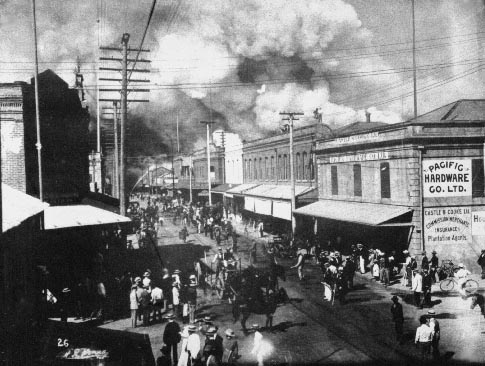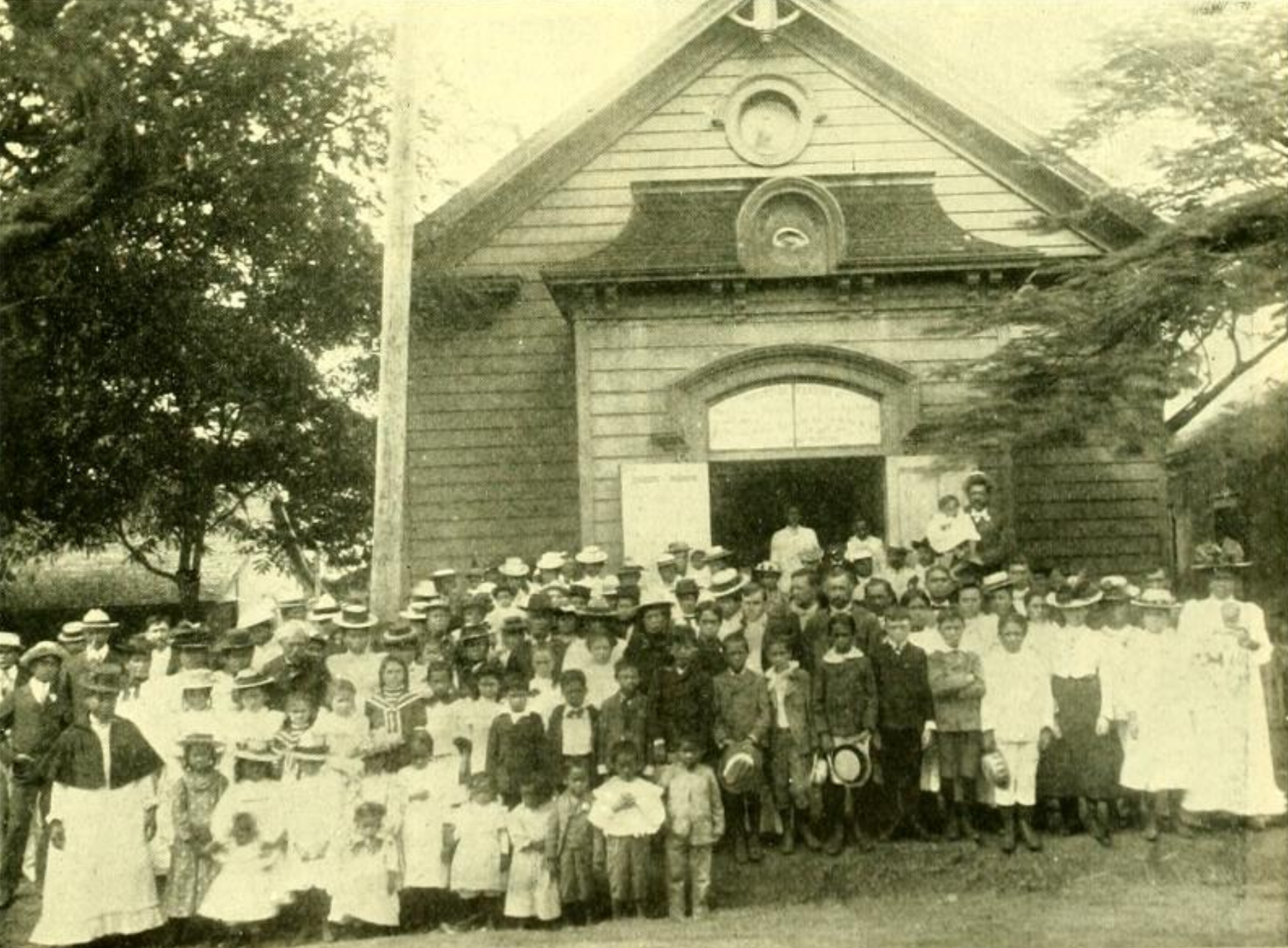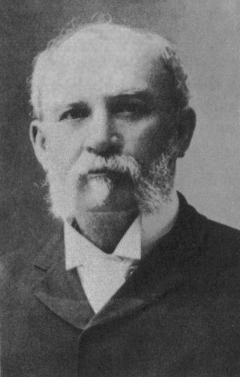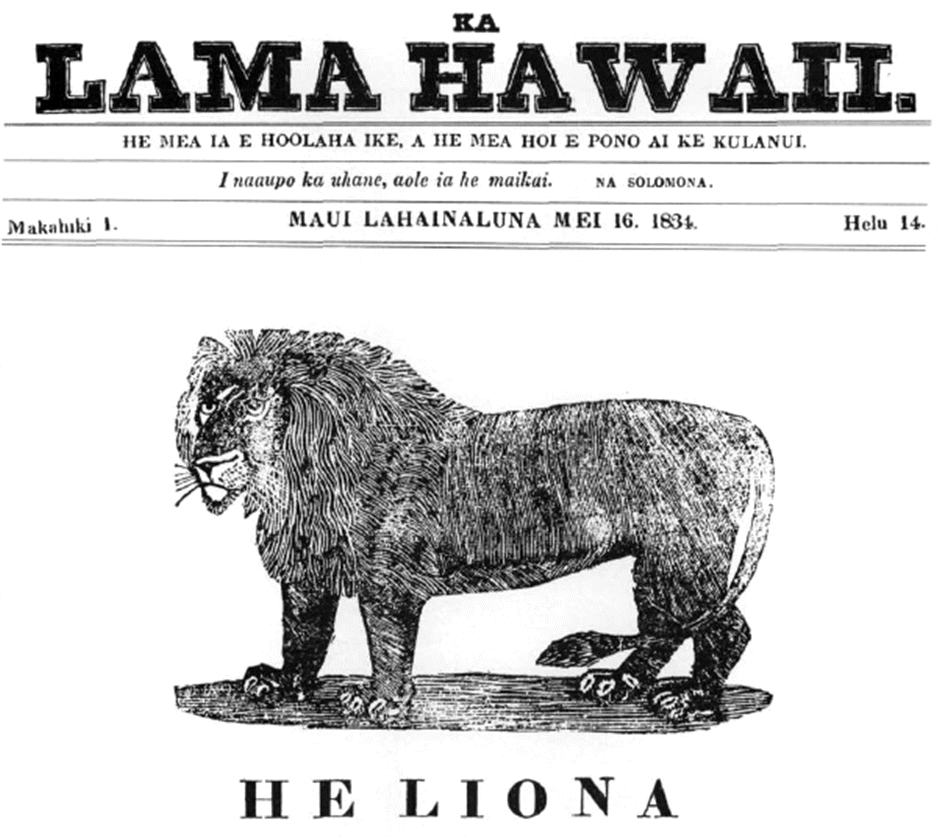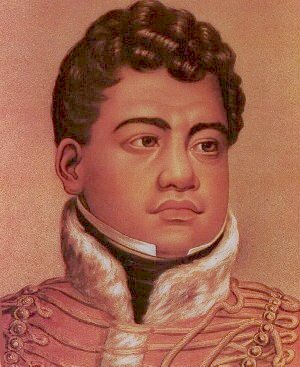|
James Wood Bush
James Wood Bush ( – April 24, 1906) was an American Union Navy sailor of British and Native Hawaiian descent. He was among a group of more than one hundred Native Hawaiian and Hawaii-born combatants in the American Civil War, at a time when the Kingdom of Hawaii was still an independent nation. Enlisting in the Union Navy in 1864, Bush served as a sailor aboard and the captured Confederate vessel , which maintained the blockade of the ports of the Confederacy. He was discharged from service in 1865 after an injury, which developed into a chronic condition in later life. The impoverished Bush was unable to return to Hawaii for more than a decade, during which time he traveled through New England and much of the Pacific. Back in Hawaii, he worked as a government tax collector and road supervisor for the island of Kauai, where he settled down. In later life, he converted to Mormonism and became an active member of the Hawaiian Mission. After the annexation of Hawaii to the Uni ... [...More Info...] [...Related Items...] OR: [Wikipedia] [Google] [Baidu] |
Honolulu
Honolulu ( ; ) is the List of capitals in the United States, capital and most populous city of the U.S. state of Hawaii, located in the Pacific Ocean. It is the county seat of the Consolidated city-county, consolidated City and County of Honolulu County, Hawaii, Honolulu, situated along the southeast coast of the island of Oahu, Oʻahu, and is the westernmost and southernmost major U.S. city as well as westernmost and southernmost U.S. state capital. It is also a major hub for business, finance, hospitality, and military defense in both the state and Oceania. The city is characterized by a mix of various Asian culture, Asian, Western culture, Western, and Oceanian culture, Pacific cultures, reflected in its diverse demography, cuisine, and traditions. is Hawaiian language, Hawaiian for "sheltered harbor" or "calm port"; its old name, , roughly encompasses the area from Nuʻuanu Avenue to Alakea Street and from Hotel Street to Queen Street, which is the heart of the present dow ... [...More Info...] [...Related Items...] OR: [Wikipedia] [Google] [Baidu] |
The Church Of Jesus Christ Of Latter-day Saints In Hawaii
The Church of Jesus Christ of Latter-day Saints (LDS Church) was established in the Hawaiian Islands in 1850, 11 years after the Edict of Toleration (Hawaii), Edict of Toleration was decreed by Kamehameha III, giving the underground Roman Catholic Diocese of Honolulu, Hawaii Catholic Church the right to worship, and at the same time allowing other faith traditions to begin establishing themselves. The church's first Mormon missionary, missionary to have success among the Hawaiians was George Q. Cannon. Among his earliest converts were men well-versed in the Hawaiian language, such as Jonatana Napela and Uaua. After the construction of the Laie Hawaii Temple, Hawaii Temple, the Latter-day Saints founded the Church College of Hawaii, now Brigham Young University-Hawaii (BYU-Hawaii), along with the associated Polynesian Cultural Center (PCC), the state's largest living museum, and an entertainment center; which draws a million visitors annually. As the Latter-day Saint population i ... [...More Info...] [...Related Items...] OR: [Wikipedia] [Google] [Baidu] |
War Of 1812
The War of 1812 was fought by the United States and its allies against the United Kingdom of Great Britain and Ireland, United Kingdom and its allies in North America. It began when the United States United States declaration of war on the United Kingdom, declared war on Britain on 18 June 1812. Although peace terms were agreed upon in the December 1814 Treaty of Ghent, the war did not officially end until the peace treaty was ratified by the 13th United States Congress, United States Congress on 17 February 1815. AngloAmerican tensions stemmed from long-standing differences over territorial expansion in North America and British support for Tecumseh's confederacy, which resisted U.S. colonial settlement in the Old Northwest. In 1807, these tensions escalated after the Royal Navy began enforcing Orders in Council (1807), tighter restrictions on American trade with First French Empire, France and Impressment, impressed sailors who were originally British subjects, even those who ... [...More Info...] [...Related Items...] OR: [Wikipedia] [Google] [Baidu] |
Kamehameha IV
Kamehameha IV (Alekanetero ʻIolani Kalanikualiholiho Maka o ʻIouli Kūnuiākea o Kūkāʻilimoku; Anglicisation, anglicized as Alexander Liholiho) (February 9, 1834 – November 30, 1863), reigned as the List of Hawaiian monarchs, fourth monarch of Hawaii under the title ''Ke Aliʻi o ko Hawaiʻi Pae ʻAina'' of the Hawaiian Kingdom, Kingdom of Hawaii from January 11, 1855, to November 30, 1863. Early life Alexander was born on February 9, 1834, in Honolulu on the island of Oahu, Oʻahu. His father was Kekūanaōʻa, High Chief Mataio Kekūanaōʻa, Royal Governor of Oʻahu. His mother was Kīnaʻu, Princess Elizabeth Kīnaʻu the ''Kuhina Nui'' or Prime Minister of the Kingdom. He was the grandson of Kamehameha I, first monarch of all the islands. Alexander had three older brothers, David Kamehameha, Moses Kekūāiwa and Lot Kapuāiwa, and a younger sister, Victoria Kamāmalu. As a toddler, Alexander was adopted by his uncle, King Kamehameha III who decreed Alexander heir to ... [...More Info...] [...Related Items...] OR: [Wikipedia] [Google] [Baidu] |
Kalākaua
Kalākaua (David Laʻamea Kamanakapuʻu Māhinulani Nālaʻiaʻehuokalani Lumialani Kalākaua; November 16, 1836 – January 20, 1891), was the last king and penultimate monarch of the Kingdom of Hawaiʻi, reigning from February 12, 1874, until his death in 1891. Succeeding Lunalilo, he was elected to the vacant throne of Hawaiʻi against Queen Emma. Kalākaua was known as the Merrie Monarch for his convivial personality – he enjoyed entertaining guests with his singing and ukulele playing. At his coronation and his birthday jubilee, the hula, which had hitherto been banned in public in the kingdom, became a celebration of Hawaiian culture. During Kalākaua's reign, the Reciprocity Treaty of 1875 brought great prosperity to the kingdom. Its renewal continued the prosperity but allowed United States to have exclusive use of Pearl Harbor. In 1881, Kalākaua took a trip around the world to encourage the immigration of contract sugar plantation workers. He wanted Hawaiians ... [...More Info...] [...Related Items...] OR: [Wikipedia] [Google] [Baidu] |
Governors Of Kauai
The Governor of Kauai () was the royal governor or viceroy of the island of Kauai and island of Niihau during the Kingdom of Hawaii. The governor was usually a male Hawaiian chief or prince, but several women also held the office. The governor had authority over the islands of Kauai and Niihau, and it was up to the governor to appoint lieutenant governors to assist them. The governor had replaced the old alii aimokus of the islands, but the sovereignty remained with the king. The first governor was the last king of Kaumualii, and it was not until his death in 1824 that Queen Kaahumanu and King Kamehameha II took control from his sons. The island governors were under the jurisdiction of the Ministers of the Interiors. Role In the 1840 Constitution of the Kingdom of Hawaii it states: ''There shall be four governors over these Hawaiian Islands - one for Hawaii - one for Maui and the Islands adjacent - one for Oahu, and one for Kauai and the adjacent Islands. All the governor ... [...More Info...] [...Related Items...] OR: [Wikipedia] [Google] [Baidu] |
Half-caste
Half-caste is a term used for individuals of Multiracial, multiracial descent. The word ''wikt:caste, caste'' is borrowed from the Portuguese or Spanish word ''casta'', meaning race. Terms such as ''half-caste'', ''caste'', ''quarter-caste'' and ''mix-breed'' were used by colonial officials in the British Empire during their classification of Indigenous peoples, indigenous populations, and in Australia used during the Australian government's pursuit of a policy of Cultural assimilation, assimilation. In Latin America, the equivalent term for half-castes was ''Cholo'' and ''Zambo''. Some people now consider the term offensive. Use by region Australia In Australia, the term "half-caste", along with any other proportional representation of Australian Aboriginal identity, Aboriginality (such as "part-aborigine", "full-blood", "quarter-caste", "octoroon", "mulatto", or "hybrid") are defunct descriptors that are highly offensive. Its use is Aboriginal Australians, Aboriginal peoples ... [...More Info...] [...Related Items...] OR: [Wikipedia] [Google] [Baidu] |
Hawaiian Language
Hawaiian (', ) is a critically endangered Polynesian language of the Austronesian language family, originating in and native to the Hawaiian Islands. It is the native language of the Hawaiian people. Hawaiian, along with English, is an official language of the U.S. state of Hawaii. King Kamehameha III established the first Hawaiian-language constitution in 1839 and 1840. In 1896, the Republic of Hawaii passed Act 57, an English-only law which subsequently banned Hawaiian language as the medium of instruction in publicly funded schools and promoted strict physical punishment for children caught speaking the Hawaiian language in schools. The Hawaiian language was not again allowed to be used as a medium of instruction in Hawaii's public schools until 1987, a span of 91 years. The number of native speakers of Hawaiian gradually decreased during the period from the 1830s to the 1950s. English essentially displaced Hawaiian on six of seven inhabited islands. In 2001, native ... [...More Info...] [...Related Items...] OR: [Wikipedia] [Google] [Baidu] |
Hapa
Hapa () is a Hawaiian word for someone of multiracial ancestry. In Hawaii, the word refers to any person of mixed ethnic heritage, regardless of the specific mixture.: "Thus, for locals in Hawai’i, both hapa or hapa haole are used to depict people of mixed-race heritage.": "Currently, Hawaiian locals use 'hapa' to refer to any individual who is racially mixed." The term is used for any multiracial person of partial East Asian, Southeast Asian, or Pacific Islander mixture in California. In what can be characterized as trans-cultural diffusion or the wave model, this latter usage has also spread to Massachusetts, Ohio, and Oregon. Both uses are concurrent. Historical and Hawaiian usage The word "hapa" entered the Hawaiian language in the early 1800s, with the arrival of Christian missionaries who instituted a Hawaiian alphabet and developed curriculum for schools. It is a transliteration of the English word "half," but quickly came to mean "part," which could be combined w ... [...More Info...] [...Related Items...] OR: [Wikipedia] [Google] [Baidu] |
Caucasian Race
The Caucasian race (also Caucasoid, Europid, or Europoid) is an Historical race concepts, obsolete racial classification of humans based on a now-disproven theory of biological race. The ''Caucasian race'' was historically regarded as a biological taxon which, depending on which of the historical race classifications was being used, usually included ancient and modern populations from all or parts of Europe, Western Asia, Central Asia, South Asia, North Africa, and the Horn of Africa. Introduced in the 1780s by members of the Göttingen school of history, the term denoted one of three purported major races of humankind (those three being Caucasoid, Mongoloid, and Negroid). In biological anthropology, ''Caucasoid'' has been used as an umbrella term for Phenotype, phenotypically similar groups from these different regions, with a focus on skeletal anatomy, and especially cranial morphology, without regard to skin tone. Ancient and modern "Caucasoid" populations were thus not exclu ... [...More Info...] [...Related Items...] OR: [Wikipedia] [Google] [Baidu] |
Native Hawaiian
Native Hawaiians (also known as Indigenous Hawaiians, Kānaka Maoli, Aboriginal Hawaiians, or simply Hawaiians; , , , and ) are the Indigenous peoples of Oceania, Indigenous Polynesians, Polynesian people of the Hawaiian Islands. Hawaiʻi was settled at least 800 years ago by Polynesians who sailed from the Society Islands. The settlers gradually became detached from their homeland and developed a distinct Hawaiian culture and identity in their new home. They created new religious and cultural structures, in response to their new circumstances and to pass knowledge from one generation to the next. Hence, the Hawaiian religion focuses on ways to live and relate to the land and instills a sense of community. The Hawaiian Kingdom was formed in 1795, when Kamehameha the Great, of the then-independent Hawaii (island), island of Hawaiʻi, conquered the independent islands of Oʻahu, Maui, Molokaʻi, and Lānaʻi to form the kingdom. In 1810, Kauaʻi and Niʻihau joined the Kingdom, the ... [...More Info...] [...Related Items...] OR: [Wikipedia] [Google] [Baidu] |
Oahu Cemetery
The Oahu Cemetery is the resting place of many notable early residents of the Honolulu area. They range from missionaries and politicians to sports pioneers and philosophers. Over time it was expanded to become an area known as the Nuuanu Cemetery. History It was the first public cemetery in Honolulu, founded in November 1844. Due to the growth in the whaling industry, discussion had started in 1836 on the need for a new burial ground that was not associated with a specific church. The site was purchased for $300 and $350 granted for a house. The money was raised by selling subscriptions on 59 plots of $12 each. Later another were purchased from Gerrit P. Judd to expand in 1860. Rev. Samuel C. Damon served on the cemetery association in the early days. The first recorded burial was American sailor H. Wolley, for $2.50. In 1906, the first public crematory in the Hawaiian Islands, designed by architect Oliver G. Traphagen opened at the cemetery. After the attack on Pearl ... [...More Info...] [...Related Items...] OR: [Wikipedia] [Google] [Baidu] |
